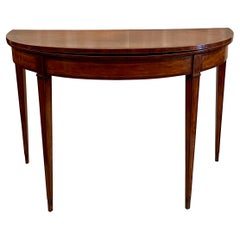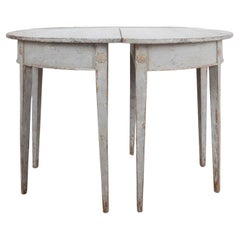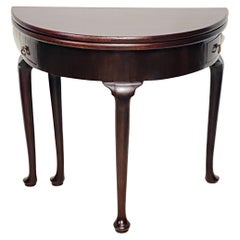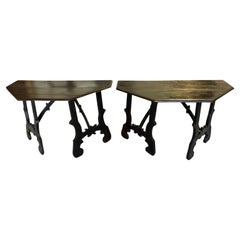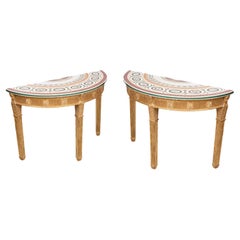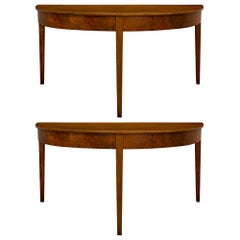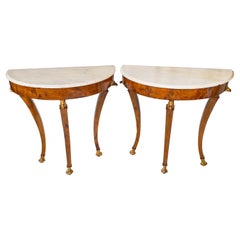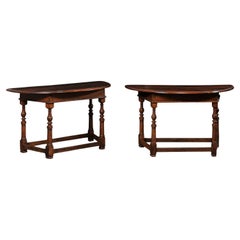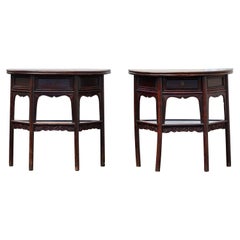Demi Lune 18th Century
Antique 18th Century English Demi-lune Tables
Mahogany
Antique 1790s Swedish Demi-lune Tables
Wood
Antique 18th Century English Georgian Demi-lune Tables
Mahogany
Antique Mid-18th Century Italian Demi-lune Tables
Walnut
Antique 18th Century Irish Adam Style Demi-lune Tables
Marble
Antique 18th Century Italian Louis XVI Demi-lune Tables
Walnut
Antique 18th Century Italian Neoclassical Demi-lune Tables
Marble
Antique 18th Century Italian Demi-lune Tables
Wood
Antique 18th Century Demi-lune Tables
Wood
Antique Early 19th Century English Georgian Demi-lune Tables
Mahogany
Antique Late 18th Century Italian Demi-lune Tables
Walnut
Antique 18th Century Demi-lune Tables
Marble
Antique 18th Century Italian Demi-lune Tables
Walnut
Antique 18th Century French Demi-lune Tables
Marble
Antique 18th Century Italian Demi-lune Tables
Marble
Antique 1760s English Georgian Demi-lune Tables
Pine
Antique Early 19th Century French Neoclassical Demi-lune Tables
Marble
Antique 18th Century Italian Demi-lune Tables
Walnut
Early 20th Century English Demi-lune Tables
Oak
Antique Early 18th Century Italian Demi-lune Tables
Walnut
Antique 18th Century and Earlier American Demi-lune Tables
Antique Mid-18th Century Italian Demi-lune Tables
Walnut
Antique Late 18th Century Italian Louis XV Demi-lune Tables
Marble
Antique Late 18th Century British Adam Style Demi-lune Tables
Pine
Antique 18th Century English George III Demi-lune Tables
Mahogany
Antique Late 18th Century British Neoclassical Demi-lune Tables
Mahogany, Yew, Burl
Antique Late 18th Century Swedish Baroque Demi-lune Tables
Iron
Antique 18th Century Demi-lune Tables
Mahogany
Antique 18th Century Italian Demi-lune Tables
Walnut
Antique 18th Century Italian Baroque Demi-lune Tables
Walnut
Antique 18th Century Italian Baroque Demi-lune Tables
Wood
Antique 18th Century Italian Demi-lune Tables
Stone
Antique 18th Century Irish Hepplewhite Demi-lune Tables
Satinwood
Antique 18th Century Chinese Chinese Export Demi-lune Tables
Wood
Antique Late 18th Century Belgian Louis XVI Demi-lune Tables
Mahogany
Antique 18th Century British Neoclassical Demi-lune Tables
Mahogany, Paint
Antique Mid-18th Century Italian French Provincial Demi-lune Tables
Walnut
Antique Late 18th Century English Adam Style Demi-lune Tables
Satinwood
Antique Late 18th Century European Country Demi-lune Tables
Oak
Antique 18th Century French Neoclassical Demi-lune Tables
Marble
Antique Early 1800s French Directoire Demi-lune Tables
Mahogany
Antique 1780s Italian Baroque Demi-lune Tables
Walnut
Antique 19th Century Italian Louis XVI Demi-lune Tables
Carrara Marble
Antique 18th Century English George III Demi-lune Tables
Marble
Antique Late 18th Century English George III Demi-lune Tables
Satinwood
Antique Late 18th Century Baltic Neoclassical Demi-lune Tables
Marble, Brass
Antique Late 18th Century English Sheraton Demi-lune Tables
Mahogany, Satinwood
Antique Late 18th Century English George III Demi-lune Tables
Mahogany
Antique 18th Century French French Provincial Demi-lune Tables
Cherry
Antique Late 18th Century Demi-lune Tables
Tulipwood
Antique 18th Century English George III Demi-lune Tables
Mahogany, Satinwood
Antique Late 18th Century English George III Demi-lune Tables
Mahogany
Antique Late 18th Century English George III Demi-lune Tables
Mahogany
Antique Late 18th Century English Georgian Game Tables
Mahogany
Antique Late 18th Century English Chinoiserie Game Tables
Gesso, Wood, Lacquer
Antique 18th Century French Louis XVI Console Tables
Marble
Antique Late 18th Century Italian Neoclassical Console Tables
Marble
- 1
Demi Lune 18th Century For Sale on 1stDibs
How Much is a Demi Lune 18th Century?
Finding the Right Demi-lune-tables for You
Antique and vintage demi-lune tables are perfect for small spaces in your home. They’re compact and versatile and have been made in all manner of styles over the years.
Demi-lune tables, which are sometimes referred to as half-moon console tables, appropriately get their name from the French term for “half-moon,” which perfectly describes the crescent shape of these elegant structures. They were especially popular in France during the 1700s, and editions designed in the Louis XVI style — a style that emerged circa 1750 — are striking in their ornate appearance, with floral accents and legs that often reflect references to columns, like fluted or ribbon-twist carvings.
Demi-lune tables are ideal for use in small spaces because they occupy little real estate. They don’t have any front corners and were designed to be positioned up against a wall or tucked behind a sofa. Many versions are supported by slender or tapered legs, ensuring that the piece has a streamlined profile.
A demi-lune table in an entryway or foyer will provide a convenient surface to stack mail or keep necessities such as your house keys while affording guests plenty of room to navigate around it. A demi-lune table is also a great place for home accents and will ensure that a decorative bowl or antique ceramic vase gets the attention it deserves as you welcome friends and family into your space.
Whether you have plenty of room to introduce a sculptural but understated new piece in the living room or are working with a small space where it’s necessary to be efficient in how you arrange your furniture, demi-lune tables are a sophisticated option.
Find a range of antique and vintage demi-lune tables today on 1stDibs.
- 1stDibs ExpertApril 5, 2022Yes, wedding rings have a long history, stretching back to ancient Egypt. The first diamond engagement ring was created in 1477 by Archduke Maximillian of Austria. Browse a wide array of vintage and contemporary wedding rings on 1stDibs.
- 1stDibs ExpertApril 5, 2022In the 18th century, art changed in style from Baroque to Rococo and Neoclassicism. Art became more ornamented and idealized during the Rococo period and then shifted toward a style that emulated the artwork of ancient Greece and Rome near the end of the century. You’ll find a variety of fine art on 1stDibs.
- 1stDibs ExpertNovember 13, 2024To identify 18th-century furniture, you can research your piece in the context of the prevailing styles of the period or consult a certified appraiser or experienced antique dealer. To identify your item on your own, look over it for maker's marks, such as carvings, stamps, brands and labels. Researching the marking can help you determine the maker of your piece, and from there, you can search further to learn more about your particular item. Without a maker's mark, the best approach is to consider the characteristics of the dominant furniture styles during the 18th century. In England, these included William and Mary, Queen Anne, Georgian, Chippendale, Hepplewhite and Sheraton. Some French furniture styles of the 1700s include Louis XV, Louis XVI and Régence. Find a diverse assortment of 18th-century furniture on 1stDibs.
- 1stDibs ExpertApril 5, 2022One way to check if your brass candlesticks are from the 18th century is to look for the two seams running lengthwise on either side. This is from when the candlestick was molded in two halves and then soldered together. You’ll find a variety of candlesticks of all shapes and sizes from some of the top sellers on 1stDibs.
- 1stDibs ExpertJanuary 10, 2025The individuals considered the Big Three of 18th-century cartoons are William Hogarth, James Gillray and George Cruikshank. Although the 18th century saw a widespread increase in illustrations in newspapers, these three illustrators were particularly well-known for their work. Hogarth's work was extremely diverse, ranging from serious, realistic paintings and portraits to satirical and moralistic illustrations filled with symbolism. A British caricaturist, Gillray is remembered today for his artworks representing political and social satires, like his political cartoons against George III of England. Despite being a prolific caricaturist, Cruikshank is now most famous for illustrating the works of Charles Dickens. On 1stDibs, find a wide variety of illustrations.
- 1stDibs ExpertApril 5, 2022At the end of the 17th century, Europe went into a frenzy over porcelain. Asian porcelain was highly sought after, and spurred the foundation of the Meissen factory in France, where hard porcelain went on to be made. You’ll find a large collection of porcelain pieces from many of the world’s top sellers on 1stDibs.
Read More
20 Inviting Dining Rooms Perfectly Arranged for Entertaining
Top interior designers show — and tell — us how to create delectable spaces for hosting dinner parties.
This Alain Delon–Designed Table Is Almost as Handsome as He Was
Fans of the French film star may be surprised to learn that he had a flair for furniture with sleek lines and disco-era flash.
Uchronia’s Plant Stand Gives Pots a Pretty Perch with All the Trimmings
Like other pieces in the firm’s Candy Box collection, the cheerful limited-edition design showcases French craft.
The Ultimate Guide to Types of Tables for the Home
Whether you’re just moving in or ready to give your home a makeover, our guide will give you pointers on tables that are fitting for every room, nook and hallway.
Is Lionel Jadot the Willy Wonka of Upcycled Belgian Design?
From his massive collaborative workshop in a former paper factory, the designer concocts funky furniture from disused materials, as well as luxe hotel interiors like the new Mix Brussels.
Inspired by the Cosmos, Sandra Nunnerley’s Nova Table Has a Futuristic Feel
The designer’s innovative use of an unexpected material gives this console a lift.
This 19th-Century Gilded Desk Displays a Fanciful Kingdom in Marquetry
The stately piece brings both gravitas and whimsy to any work space.
In Guadalajara, These Luscious Side Tables Are Chiseled from Volcanic Rock
Use them as tables or stools, indoors or out.
